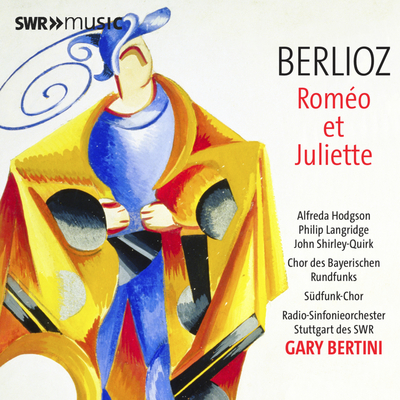Berlioz, Hector: Roméo et Juliette op. 17

Artikelinfo
1982
2025
Hector Berlioz
Alfreda Hodgson
Philip Langridge
Stephen Roberts (Correction to artwork!)
Chor des Bayerischen Rundfunks
Radio-Sinfonieorchester Stuttgart des SWR
Gary Bertini (dir)
Disc 1 (61:23)
Première Partie
1 I. Introduction: Combats – Tumulte – Intervention du Prince
2 Récitatif choral: D’anciennes haines endormies
3 Strophes: Premiers transports que nul n’oublie!
4 Récitatif: Bientôt de Roméo la pâle reverie …
5 Mab, la messagère fluette et légère. Scherzetto
Deuxième Partie
6 II. Roméo seul – Tristesse –Bruit lointain de concert
et de bal – Grand Fête chez Capulet
7 Fête
8 III. Scène d’amour. Nuit sereine – Le jardin de Capulet,
silencieux et désert – Les jeunes Capulets,
sortant de la fête, passent en chantant des
réminiscences de la musique du bal
9 Scène d’amour
10 IV. La Reine Mab, ou la Fée des songes. Scherzo
Disc 2 (38:42)
Troisième Partie
1 V. Convoi funèbre de Juliette. Marche fuguée:
« Jetez des fleurs pour la vierge expirée! »
2 VI. Roméo au tombeau des Capulets
3 Invocation – Réveil de Juliette – Joie délirante, désespoir,
dernières angoisses et mort de deux amants
4 VII. Final. La foule accourt au cimetière. Rixe des Capulets
et des Montagus: « Quoi! Roméo de retour! »
5 Récitatif: « Je vais dévoiler le mystère »
6 Air: « Pauvres enfants que je pleure! »
7 « Mais notre sang rougit leur glaive »
8 Serment: « Jurez donc par l’auguste symbole »
When Hector Berlioz, aged 23, saw Shakespeare’s Romeo and Juliet for the first time in 1827, he was deeply moved by the experience, no doubt in appreciation of the Irish actress Harriet Smithson, who played Juliet. The two got married in 1833 and, six years later, Berlioz completed his Roméo et Juliette, Op. 17, a grand work that incorporates elements of symphony, opera and oratorio. It was not intended as an attempt to faithfully transpose Shakespeare’s drama; not a single verse of Shakespeare’s text was included in the libretto, which was written by the poet Émile Deschamps, based on Berlioz’s drafts. When the Prologue refers to Shakespeare as the only person who knew the highest secrets of poetry, it’s clear that the listener is deliberately placed in Berlioz’s perspective, whose imagination is ignited by Shakespeare’s genius. Berlioz’s second symphony, Harold in Italy, was similarly based on a poem by Lord Byron, with Berlioz adapting the original very freely, developing entire movements from episodes that are of only minor importance in the poem, and adding scenes that do not appear there at all.
This live recording from 1982 showcases Gary Bertini at the peak of his career, conducting the SWR Stuttgart Radio Symphony Orchestra and an exquisite cast of singers – Alfreda Hodgson
(mezzo-soprano), Philip Langridge (tenor) and John Shirley-Quirk (baritone). The internationally renowned Chor des Bayerischen Rundfunks and SWR Vokalensemble (known until 1998 as
Südfunk-Chor) also feature in this performance of one of the most complex symphonic works of the Romantic era.